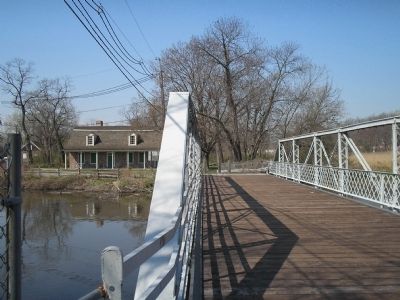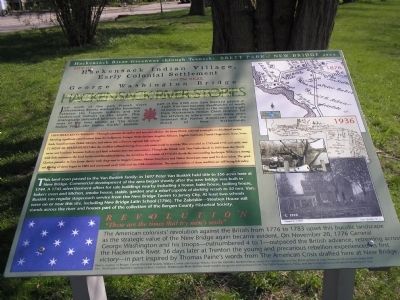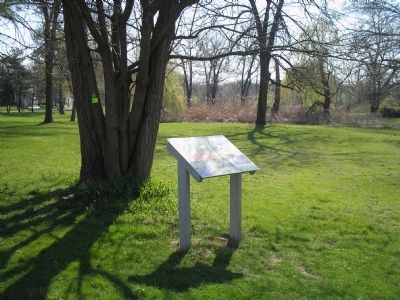Teaneck in Bergen County, New Jersey — The American Northeast (Mid-Atlantic)
Brett Park / New Bridge Area
Hackensack River Greenway through Teaneck
— Hackensack River Stories —
Site of:
and The Real
George Washington Bridge
This 10½ acre park named after Teaneck Mayor and open space advocate Clarence “Jim” Brett is one of the most historically significant site in Teaneck, indeed the Hackensack River Valley.
Just north of the park French Creek (Hesawakey Brook) marked the boundary between the Tappan Indians and the Hackensack Indians to the south. This strategically defended location on the narrows of the river known as “the Great Indian Field – the Indian Castle” became part of the 2100 acre Sara Kiersted patent in 1669. Kiersted became deedholder of much of modern day Teaneck as the result of a gift from Hackensack Indian Chief Oratam for her services as interpreter over many years between the Native Americans and the Dutch of New Neatherlands.
Historian Kevin Wright: “Through a process of conflict and accommodation, the Jersey Dutch achieved a complex multicultural society, blending significant contributions from the indigenous Lenape, Neatherlanders, Angolan Africans, English, Germans, French Huguenots, Scots, Scots-Irish, Scandinavians, Polish Silesians, and others into a distinct regional folk culture”.
It must be remembered that the conflicts suffered during these early years could be terrible. Wars recorded in 1743 and 1755 and raids, massacres and butchery between Indians and local colonists were not uncommon. Though the British took New Netherlands in 1664 from the Dutch with little resistance, the local battles and bloodshed during the American Revolution of 1776-83 shook the surrounding landscape. Without a strong Quaker presence in East Jersey slavery took deep root in Bergen County. African Americans and Native Americans were used for slave labor. The gradual freeing of slaves began in 1804 and continued until 1866 and the 13th amendment. The reverberations of these conflicts are still being felt today.
This land soon passed to the Van Buskirk family: in 1697 Peter Van Buskirk held title to 356 acres here at New Bridge. Commercial development of the area began shortly after the new bridge was built in 1744. A 1745 advertisement offers for sale buildings nearby including a house, bake house, bolting house, bakers oven and kitchen, smoke house, stable, garden and a wharf capable of docking vessels to 50 tons. Van Buskirk ran regular stagecoach service from New Bridge Tavern to Jersey City. At least two schools were on or near this site, including New Bridge Latin School (1766). The Zabriskie – Steuben House still stands across the river and houses part of the collection of the Bergen County Historical Society.
REVOLUTION
“These are the times that try men’s souls”
The American colonists’ revolution against the British from 1776 to 1783 upset this bucolic landscape as the strategic value of the New Bridge again became evident. On November 20, 1776 General George Washington and his troops – outnumbered 4 to 1 – outpaced the British advance, retreating across the Hackensack River. 36 days later at Trenton the young and precarious rebellion experienced its first victory – in part inspired by Thomas Paine’s words from The American Crisis drafted here at New Bridge.
Topics. This historical marker is listed in these topic lists: Colonial Era • War, US Revolutionary. A significant historical month for this entry is November 1851.
Location. 40° 54.841′ N, 74° 1.783′ W. Marker is in Teaneck, New Jersey, in Bergen County. Marker is on Main Street (Old New Bridge Road), on the left when traveling west. Touch for map. Marker is in this post office area: Teaneck NJ 07666, United States of America. Touch for directions.
Other nearby markers. At least 8 other markers are within walking distance of this marker. New Bridge (a few steps from this marker); These are the times that try men’s souls . . . (a few steps from this marker); Cattails = Clay (a few steps from this marker); a different marker also named New Bridge (within shouting distance of this marker); Timeline of Events at New Bridge in the American Revolution

Photographed By Bill Coughlin, April 19, 2008
3. New Bridge over the Hackensack River
This bridge, located near the marker, is the site where George Washington and the Continental Army crossed the Hackensack River during their retreat across New Jersey in November of 1776. The Steuben House can be seen on the far side of the river.
More about this marker. Along the right side of the marker are maps of the area from 1876 and 1936, as well as photos from 1910 and 1965. The lower left of the marker features a picture of Gen. Washington’s flag, courtesy of Kevin Tremble.
Credits. This page was last revised on June 16, 2016. It was originally submitted on February 12, 2011, by Bill Coughlin of Woodland Park, New Jersey. This page has been viewed 1,008 times since then and 29 times this year. Photos: 1, 2, 3. submitted on February 12, 2011, by Bill Coughlin of Woodland Park, New Jersey.

